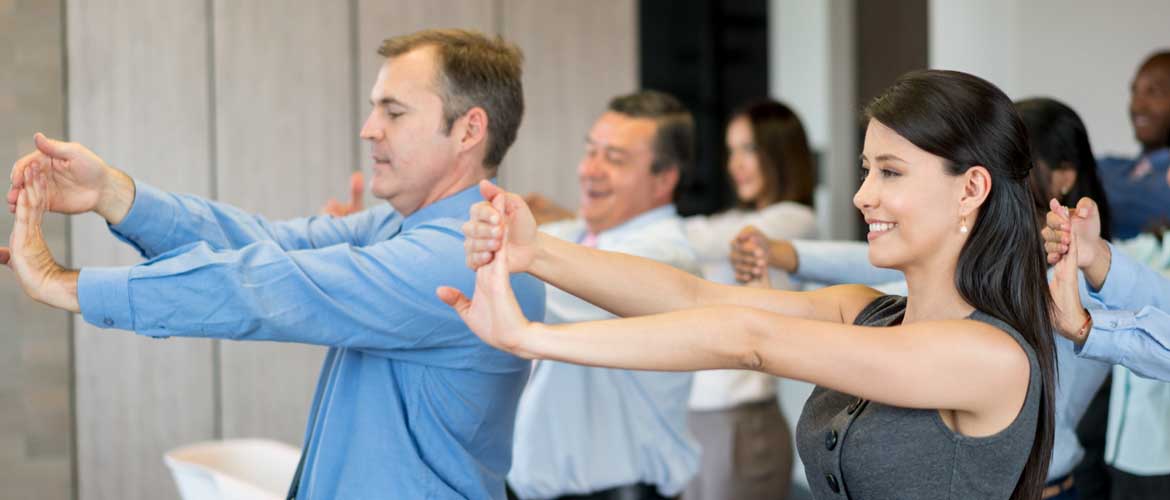March 12, 2018
Before you say “I don’t have time for that,” consider the research. Studies show that sitting for long periods of time can lead to various health problems, including obesity, heart disease, and possibly cancer. When you sit for an extended period of time, it tends to stall the processes related to breaking down the fats and sugars in your body.1 These are just a few of the many reasons why getting a little exercise at work is important throughout the day.
If you need some ideas, try our five suggestions on ways to stay active during the daily grind.
1. Stretch at Your Desk
Many aches and injuries that happen in the workplace can be prevented by a little midday stretching. Try the following stretches throughout your workday to get your blood flowing and loosen those muscles.
Triceps Stretch
Stretching your triceps may help with upper back or shoulder tension experienced after sitting for long periods of time at your desk.
- Stand tall with your arms at your sides.
- Lift one arm up overhead, bend your elbow, and reach your hand down your back as far as you can. Use your opposite hand to give gentle assistance until you feel a stretch. Exhale and hold for two seconds.
- Relax and return to the starting position.
- Complete the set on one side before repeating with the opposite arm. Be sure to keep your back straight and torso engaged throughout the stretch. You should feel it stretching your triceps, upper back, and shoulder.
Wrist Stretch – Extension
Stretching your wrists may be helpful for those typing on a keyboard most of the workday, as well as those with carpal tunnel.
- Stand with one arm extended in front of you, palm up, with the other hand on top.
- Extend your wrist as if you are trying to point your fingers at the ground. Then give gentle assistance with your opposite hand and hold for two seconds.
- Relax and return to the starting position.
- Complete the set on one side before repeating with the opposite arm. Be sure to actively try to extend your wrist throughout the movement.
Hamstring Stretch
A hamstring stretch may help to relieve tension in your lower back, often experienced after sitting for long periods.
- Stand tall with your feet placed wider than hip-width apart.*
- Bend forward at your waist to grab your toes with your hands.
- Drop down into a deep squat while keeping your arms straight, elbows inside your knees, back flat, and chest up.
- While holding your toes, raise your hips back and straighten your knees until you feel a good stretch in the back of your legs. Hold for one to two seconds.
- Be sure to keep your arms straight, back flat, and chest up throughout the movement. You should feel it stretching your glutes and hamstrings.
If you have difficulties with balancing, modify this stretch by sitting on a flat surface and bending forward at your waist to grab your toes with your hands. Hold for 15 to 30 seconds. This is another great way to get a good stretch throughout your leg muscles.
These are just a few examples of stretches that you can do without leaving your desk. If you feel any pain during a stretch, there may be an injury or damage in the tissue. Stop stretching that muscle and see your doctor to make sure your stretching routine is right for you.
2. Stand for Part of Your Workday

Is sitting really the new smoking? This phrase is becoming more and more common, and it stems from research showing that the more time you spend sitting, the higher your chances are for Type 2 diabetes, heart disease, cancer, and back pain.1
Many workplaces are beginning to offer standing desks for these health benefits, but keep in mind that simply standing is not the best way to increase your activity. While it does work to strengthen various muscles and prevents you from sitting still for eight or more hours a day, walking burns substantially more calories. In order to stay active every day and reduce your chances of chronic illnesses, get a healthy mix of sitting, standing, and exercise if you are physically able.
MedExpress Pro Tip: During conference calls, make it a priority to stand and try some light exercises, such as arm circles or squats.
If you don’t have a standing desk, improvise with a high table or elevate your computer on a stack of books.
3. Use Technology to Your Advantage

Digital pedometers or activity trackers that sync updates to your mobile phone - a.k.a. “wearables” - are one of the latest trends in everyday fitness technology. There are several brands of trackers that will count your steps, heart rate, calories burned, etc. If a wearable isn’t something you’re interested in, there are plenty of free smartphone apps to choose from that can track your steps when you have your phone with you.
MedExpress Pro Tip: Set an alarm on your computer, smartphone, or pedometer every 30 or 60 minutes to remind you to get up and move. How often you should get exercise at work depends on how sedentary your day-to-day lifestyle is. However, the American Heart Association recommends 10,000 steps a day.
If you’re someone who lives by your calendar or daily planner, pencil in some time for exercise or a quick walk during the day. You may even want to invite a co-worker. Not only is it a visual reminder, but you’re more likely to get moving if it is scheduled and if you have someone else to encourage you.
4. Change Some of Your Everyday Habits
There are plenty of daily routines that you may never think twice about, but they could be holding you back from getting some extra steps. Take a few moments to think about your day in the workplace and what prompts you to get up and move.
Are you using the restroom closest to you?
Depending on your work environment, each floor has at least one restroom. Start training yourself to take the stairs or walk a little farther to another one.
Is your default printer the one that is near your desk?
If your office has multiple printers, and if you are able to change your default, choose one that will force you to get some extra steps in.
Do you take the parking spot that is closest to the door?
This is a habit that you can work to break no matter where you are. Take a parking spot that isn’t the most convenient at work, at the grocery store, or when picking your kids up from school. It’s a plus if the kids get a few extra steps in, too.
Can you take the stairs instead of the elevator?
You might be surprised at how much time you can save by taking the stairs instead of waiting for the elevator every morning. If there are too many flights for you to handle all at once, get off the elevator a floor or two below, then take the stairs for the remainder.
5. Join a Health and Wellness Program at Work
Many employers offer monthly or quarterly challenges that focus on exercise, a healthy diet, or mindfulness. Talk with your Human Resources Department to see what is offered and how you can get involved.
If your employer currently doesn’t offer a program, take the initiative with your coworkers and start one! You could create a walking challenge to see who can attain the most miles or form a softball team that raises money for a charity. Even having a meeting while walking once or twice a week is a way to work towards deadlines while getting exercise at work. These are just some examples; see what motivates you and your coworkers and get creative.
*Talk to your doctor before beginning any new exercise regime.
References:
1 Levine J. What are the risks of sitting too much? Mayo Clinic. Updated September 4, 2015. Accessed January 31, 2018.

